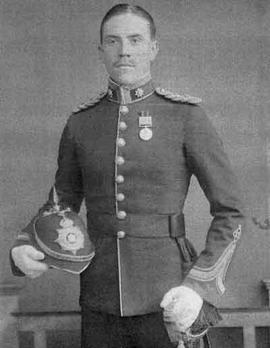Elliston, Francis Albert Neville, son of Sir George Sampson Elliston MC MP, barrister-at-law, of Elmsett, Suffolk, and Alice Louise, d. of Joseph Causton DL of Bickley, Kent; b. 10 Mar. 1907; adm. Sept. 1920 (H); left July 1923; St Catb. Coll. Camb., matric. 1923, BA 1926, MA 1930; sec. Public Dental Assn of Gt Britain 1939; E. Lancs Regt 1940-3, Parachute Regt 1943 (Capt.); m. 22 Oct. 1935 Mary Muir, d. of Robert James Muir Wilson of St Helen's, Lancs; killed in action (Normandy) 8 June 1944.
Francis Albert Neville Elliston was born at Paddington, London on the 10th of March 1907 the second son of Sir George Sampson Elliston MC, MP, MA, DL, JP, barrister at law, and Lady Alice Louise (nee Causton) Elliston of 1, Warrington Crescent, Lancaster Gate, later of 40, Heathcroft, Golders green in Middlesex. He was christened at Christ Church, Lancaster Gate on the 11th of April 1907.
He was educated at Westminster School where he was up Homeboarders from September 1920 to July 1923 and rowed for the 2nd IV in 1923.
He matriculated for St Catharine’s College, Cambridge as a pensioner on the 23rd of October 1923 where he read History and Law. He rowed for the College at stroke in the second May Boat in 1925 and graduated with a BA on the 29th of June 1926. During his time at Cambridge he was a regular contributor of “witty and clever articles” to the Cambridge University student magazine, the “Granta”. He was also a keen member of the Oxford Group. He qualified as a barrister and worked at Lincoln’s Inn. He was awarded a MA on the 13th of June 1930.
He was married at The Church of St Mary the Great, Cambridge on the 22nd of October 1934 to Mary (nee Muir-Wilson) of Windle Grange, St Helens in Lancashire; they had a son, Robin, born on the 13th of October 1936.
He enlisted as a Private in the 1/7th Battalion, Middlesex Regiment in the Territorial Army in 1939 and rose to the rank of Corporal before attending the 168th Officer Cadet Training Unit from where he was commissioned as a 2nd Lieutenant in the East Lancashire Regiment on the 10th of February 1940. He was promoted to Lieutenant on the 1st of June 1943. He volunteered for airborne training and attended Course No. 72 at RAF Ringway from the 12th to the 23rd of July 1943. The instructors noted that Francis Elliston was a: - “Fine type of officer and a good parachutist”.
The 13th Battalion, Parachute Regiment landed at Drop Zone N, to the north of the village of Ranville, in Normandy at 12.50am on the 6th of June 1944. The Battalion assembled and moved off from their rendezvous point on the drop zone at 2.30am with Ranville reported as having been cleared of the enemy by 3am. The Battalion was still holding the area around Ranville on the 8th of June when Francis Ellison was shot in the chest and killed at 11.30am.
His Colonel wrote: - “All of us, officers and men, have lost one of our best friends and a most able and efficient comrade.”
The Westminster school magazine, the “Elizabethan”, wrote of him: - “At one time he was actively engaged in the services of the Oxford Group, in which, as indeed in all his work, his cheerful disposition and capacity for friendship won for him the deep affection of a wide circle.”
The St Catharine’s College magazine wrote: -
“He was educated at Westminster before coming to S. Catharine's where his cheerfulness and determination proved a potent force in College rowing. But at heart he was a crusader, and as one he went into the war. For a time he held a commission in The East Lancashire Regiment, then recruited mainly from his father's constituency, but he transferred to the Parachute Regiment and led the Normandy invasion. Less than forty eight hours after dropping he was killed.”
He is commemorated on the St Helens Roll of Honour and on the war memorials at Lincoln’s Inn and at St Catharine’s College, Cambridge.
He is buried at Ranville War Cemetery Plot IA, Row E Grave 12.
